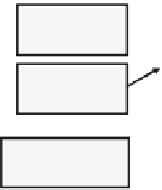Graphics Reference
In-Depth Information
Intra Mode Information
Inter Mode Information
Entropy
Decoding
Sample A
daptive Offset Inform
ation
Residues
Intra
Prediction
Inverse
Quantization
Inverse
Transform
Reconstruction
Motion
Compensation
Deblocking Filter
Decoded Picture
Buffer
Sample Adaptive Offset
Fig. 7.1
Block diagram of HEVC decoder. Reproduced with permission from [
13
], © 2012 IEEE
the quality of the decoded picture by reducing the ringing artifacts and changes in
the sample intensity of areas of a reconstructed picture. Since the deblocking and
SAO attenuate different artifacts, their benefits are additive when used together. An
HEVC encoder can turn on and off each of the in-loop filters independently.
Modern video coding standards try to remove as much redundancy from the
coded representation of video as possible. One of the sources of redundancy is
the temporal redundancy, i.e. similarity between the subsequent pictures in a video
sequence. This type of redundancy is effectively removed by motion prediction.
Another type of redundancy is spatial redundancy and is removed by intra-
prediction from the neighboring samples and spatial transforms. In HEVC, both
the motion prediction and transform coding are block-based. The size of motion-
predicted blocks varies from 8
4and4
8, to 64
64 luma samples, while the
size of block transforms and intra-predicted blocks varies from 4
4to32
32
samples.
These blocks are coded relatively independently from the neighboring blocks and
approximate the original signal with some degree of similarity. Since coded blocks
only approximate the original signal, the difference between the approximations
may cause discontinuities at the prediction and transform block boundaries [
27
,
36
,
37
]. These discontinuities are attenuated by the deblocking filter.
Larger transforms used in HEVC can also introduce more ringing artifacts
compared to H.264/AVC that mainly come from quantization error of transform
coefficients [
17
]. In addition to that, HEVC uses 8 or 7-tap fractional luma sample
interpolation and 4-tap fractional chroma sample interpolation, while H.264/AVC
uses 6-tap and 2-tap for luma and chroma respectively. A higher number of
interpolation taps can also lead to more ringing artifacts. These artifacts are
corrected by a new filter: sample adaptive offset (SAO). As shown in Fig.
7.1
,SAO
is applied to the output of the deblocking filter when the deblocking filter is turned
on, otherwise, it is applied to the reconstructed picture
There are several reasons for making in-loop filters a part of the standard. In
principle, the in-loop filters can also be applied as post-filters. An advantage of







































